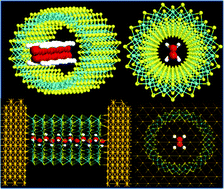Electronic and transport properties of PSi@MoS2 nanocables
Abstract
Electronic structures and transport properties of prototype MoS2 nanotube (15, 0) nanocables, including undoped PSi@MoS2 and B- and P-doped PSi@MoS2 (where PSi refers to polysilane), are investigated using the density functional theory (DFT) and the non-equilibrium Green's function (NEGF) methods. It is found that transport properties of two-probe systems by sandwiching finite long nanocables between two Au electrodes are basically in agreement with the electronic structures of their corresponding infinitely long systems. Encapsulating undoped and doped PSi nanowires inside the MoS2 nanotubes could not significantly affect the electronic and transport properties. B-doping and P-doping upon PSi play different roles in the electronic and transport properties. B-doping may exert constructive and destructive effects on electron transport depending on its position and applied bias direction, while P-doping displays a negligible effect. In addition, we found that bi-doping by two adjacent B atoms could slightly enhance the conductivity. These results could offer some clues for conducting experiments to achieve nanoelectronic devices with intrinsic transport properties of MoS2 nanotubes.


 Please wait while we load your content...
Please wait while we load your content...